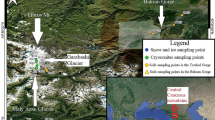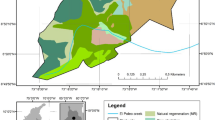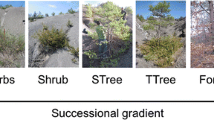Abstract
Morphological, physicochemical, and isotopic properties of a two-member soil complex developed under dry steppe have been studied in the central part of the Manych Depression. The soils are formed on chocolate-colored clayey sediments, and have pronounced microrelief and the complex vegetation pattern. A specific feature of the studied soil complex is the inverse position of its components: vertic chestnut soil occupies the microhigh, while solonetz is in the microlow. The formation of such complexes is explained by the biological factor, i.e., by the destruction of the solonetzic horizon under the impact of vegetation and earth-burrowing animals with further transformation under steppe plants and dealkalinization of the soil in the microhighs. The manifestation of vertic features and shrink-swell process in soils of the complex developing in dry steppe are compared with those in the vertic soils of the Central Pre-Caucasus formed under more humid environment. It is supposed that slickensides in the investigated vertic chestnut soil are relict feature inherited from the former wetter stage of the soil development and are subjected to a gradual degradation at present. In the modern period, vertic processes are weak and cannot be distinctly diagnosed. However, their activation may take place upon an increase of precipitation or the rise in the groundwater level.
Similar content being viewed by others
References
B. D. Abaturov, “On the Effects of Steppe Voles,” Pochvovedenie, No. 2, 95–100 (1963).
E. V. Arinushkina, Manual on the Chemical Analyses of Soils (Izd. Mosk. Gos. Univ., Moscow, 1970) [in Russian].
Yu. N. Ashinov, T. A. Zubkova, I. I. Imgrut, and L. O. Karpachevskii, Soil and Society (Adygeya, Maikop, 2006) [in Russian].
L. P. Budina, “Types of Solonetzic Complexes,” in Soils of the Complex North Caspian Plain and Their Reclamation Characteristics (Nauka, Moscow, 1964), pp. 196–258 [in Russian].
T. L. Bystritskaya and A. N. Tyuryukanov, Black Vertisols of Eurasia (Nauka, Moscow, 1971) [in Russian].
Problems of the Amelioration of Forage Resources in Steppe, Semidesert, and Desert Zones of the USSR (Izd. Akad. Nauk SSSR, Leningrad, 1954) [in Russian].
F. Ya. Gavrilyuk, Soils of Irrigated Regions in Rostov Oblast (Rostizdat, Rostov, 1951) [in Russian].
Geology of the USSR, Vol. XLVI (Nedra, Moscow, 1970) [in Russian].
A. A. Gol’eva, “Buried Dark-Colored Soils of the Ergeni Upland,” in Modern Natural and Anthropogenic Processes in Soils and Geosystems (Pochv. Inst. im. V.V. Dokuchaeva, Moscow, 2006), pp. 176–205 [in Russian].
P. V. Grishin and E. I. Lomako, Genesis of Vertic Soils in the European Forest-Steppe Zone (Izd. Kazansk. Univ., Kazan, 1972) [in Russian].
V. A. Devyatykh, “On the Nature of Low-Sodium Solonetzes” in Solonetzes and Their Agricultural Use (Nauch. Tr. Pochv. Inst. im. V.V. Dokuchaeva, Moscow, 1975), pp. 16–31 [in Russian].
A. G. Doskach, Natural Zoning of the Caspian Semidesert (Nauka, Moscow, 1979) [in Russian].
S. V. Zonn and O. A. Dakhab, “Slito- and Vertigenesis in Soils of the Temperate Tropical Zones,” Pochvovedenie, No. 12, 48–61 (1984).
E. N. Ivanova and F. Ya. Levina, “Solonetzic Complexes of the Caspian Region,” Pochvovedenie, No. 10, 909–919 (1952).
E. N. Ivanova and V. M. Fridland, “Soil Complexes of Dry Steppes and Their Evolution,” in Problems of the Amelioration of Forage Resources in Steppe, Semidesert, and Desert Zones of the USSR (Izd. Akad. Nauk SSSR, Moscow, 1954), pp. 162–190 [in Russian].
Classification and Diagnostics of Soils of the USSR (Kolos, Moscow, 1977) [in Russian].
I. V. Kovda, Extended Abstract of Candidate’s Dissertation in Geography (Moscow, 1992).
F. I. Kozlovskii, Modern and Natural and Anthropogenic Processes of Soil Evolution (Nauka, Moscow, 1991).
E. A. Kornblyum and F. I. Kozlovskii, “Slitye Soils of the Volga-Akhtuba Floodplain as an Analogue of Dark Vertisols in Tropical and Subtropical Regions,” in Geography and Classification of the Soils of Asia (Nauka, Moscow, 1965), pp. 165–178 [in Russian].
E. A. Kornblyum, I. N. Lyubimova, and T. V. Tursina, “Mosaic Soil Profiles and Their Description,” Pochvovedenie, No. 8, 145–153 (1972).
V. F. Maksimova, “On the Origin of Complex Patterns of Soils and Vegetation in the Western Caspian Region,” in Problems of the Amelioration of Forage Resources in Steppe, Semidesert, and Desert Zones of the USSR (Izd. Akad. Nauk SSSR, Moscow, 1954), pp. 220–243 [in Russian].
M. B. Minkin, V. M. Babushkin, and P. A. Sadimenko, Solonetzes in the Southeast of Rostov Oblast (Izd. Rostovsk. Gos. Univ., Rostov-on-Don, 1980) [in Russian].
D. S. Orlov and L. A. Grishina, Practicum on the Biochemistry of Humus (Izd. Mosk. Gos. Univ., Moscow, 1981) [in Russian].
A. D. Panadiadi, The Baraba Lowland (Gos. Izd. Geogr. Lit., Moscow, 1953) [in Russian].
N. P. Panov, Extended Abstract of Doctoral Dissertation in Agriculture (Moscow, 1972) [in Russian].
L. N. Plekhanova, V. A. Demkin, and G. B. Zdanovich, Soil Evolution in River Valleys of Transural Steppes in the Second Half of the Holocene (Nauka, Moscow, 2007) [in Russian].
Field Guide of Correlation of Russian Soils (Pochv. Inst. im. V.V. Dokuchaeva, Moscow, 2008) [in Russian].
A. A. Popov, N. E. Varlamov, and N. N. Konovalov, “On the Complexes of Floodplain Meadow Dark-Colored Vertic Soils in the Volga-Akhtuba Floodplain,” Pochvovedenie, No. 8, 36–43 (1964).
A. A. Popov, A. N. Rudenko, and V. M. Chervyatsova, “An Experience in Application of aerial Imagery for Soil-Reclamation Studies in the Lower Volga Region,” in Materials of the Regional Workshop on Soil Reclamation in the North Caucasus (Yuzhgiprovodkhoz, Rostovon-Don, 1969), pp. 93–100 [in Russian].
Soil Regions of the Caspian Lowland and Prospects for Its Agricultural Use (Nauchn. Tr. Pochven. Inst. im. V.V. Dokuchaeva (Moscow, 1977) [in Russian].
Soils of Bashkiria, Vol. 1 (Ufa, 1973) [in Russian].
Soils of the Complex North Caspian Plain and Their Reclamation Characteristics (Nauka, Moscow, 1964) [in Russian].
Soils. Methods for Determining the Organic Matter Content (Izd. Standartov, Moscow, 1992) [in Russian].
M. K. Sapanov, “The Impact of Climate Changes on the Soil Hydromorphism in the Northern Caspian Region,” Aridn. Ekosistemy 16(5), 25–30 (2010).
A. A. Svitoch, “The Khvalyn Transgression of the Caspian Sea: Not the Result of the Inflow of Glacial Meltwater from Siberia and Not the Deluge,” Byull. Mosk. O-va Ispyt. Prir., Otdel. Geol. 83(4), 25–37 (2008).
A. A. Svitoch, T. A. Yanina, N. G. Novikova, V. M. Sobolev, and A. A. Khomenko, Pleistocene Deposits in the Manych Valley. Problems of Morphology and Evolution (Geogr. Dept., Mosk. Gos. Univ., Moscow, 2010) [in Russian].
Slitozems and Slitic Soils, Ed. by E. M. Samoilova (Izd. Mosk. Gos. Univ., Moscow, 1990) [in Russian].
Vertic Soils of Moldova. Genesis, Properties, and Use (Shtiintsa, Chisinau, 1990) [in Russian].
Reference Book on the Climate of the USSR, Iss. 13, Part 2 (Gidrometeoizdat, Leningrad, 1966) [in Russian].
Reference Book on the Climate of the USSR, Iss. 13, Part 4 (Gidrometeoizdat, Leningrad, 1968) [in Russian].
L. N. Tashninova and A. P. Bogun, “Specific Features of Vertic Soils on the Ergeni Upland” in Vertic Soils: Genesis, Properties, and Social Significance (Materials of the 1st Int. Conf., Maikop, 1998), pp. 17–18 [in Russian].
Theory and Practice of the Chemical Analysis of Soils, Ed. by L.A. Vorob’eva (Geos, Moscow, 2006) [in Russian].
N. B. Khitrov, Genesis, Diagnostics, Properties, and Functioning of Swelling Clay Soils in the Central Ciscaucasus (Moscow, 2003) [in Russian].
N. B. Khitrov, “Modern Tendencies of Soil Development in the Steppe Zone,” in Modern Natural and Anthropogenic Processes in Soils and Geosystems (Pochv. Inst. im. V.V. Dokuchaeva, Moscow, 2006) [in Russian].
V. A. Khmelev and A. A. Tanasienko, Chernozems of the Kuznetsk Depression (Nauka, Novosibirsk, 1983) [in Russian].
A. A. Khomenko, “Morphology of Ridged Relief in the Manych Depression,” in Problems of Paleogeography and Stratigraphy of the Pleistocene (Izd. Mosk. Gos. Univ., Moscow, 2008), No. 2, pp. 205–211 [in Russian].
A. L. Chepalyga, T. A. Sadchikova, N. B. Leonova, et al., “The Caspian-Black Sea Water Exchange along the Manych-Kerch Strait in the Late Pleistocene,” in Ecology of the Anthropogene and Modern Period: Nature and Humans (St. Petersburg, 2004), pp. 50–53 [in Russian].
O. A. Chichagova, Radiocarbon Dating of Soil Humus (Nauka, Moscow, 1985) [in Russian].
O. A. Chichagova, A. L. Aleksandrovskii, S. V. Goryachkin, and I. V. Kovda, “Radiocarbon Studies as the Basis for Assessing Carbon Fluxes in the Soil-Atmosphere System,” Izv. Akad. Nauk, Ser. Geogr., No. 4, 107–112 (2001).
N. P. Shabanova, Extended Abstract of Candidate’s Dissertation in Biology (Institut Lesoved. Ross. Akad. Nauk, Moscow, 2011).
N. Ahmad, “Vertisols,” in Pedogenesis and Soil Taxonomy. II. The Soil Orders, Ed. by L. P. Wilding, N. E. Smeck, and G. F. Hall, (Elsevier, Amsterdam-Oxford-New York, 1983), pp. 91–123.
Kh. Arslanov and T. Yanina, “Radiocarbon Age of the Khvalynian Manych Passage,” Extended Abstr. IGCP, INQUA Fourth Plenary Meeting and Field Trip, 4–16 Oct. 2008, Varna, Bulgaria, pp. 15–18.
N. S. Bolikhovskaya and N. S. Kasimov, “Environmental and Climatic Evolution of the Lower Volga River Region during the Last 10 Kyr,” in The Caspian Region: Environmental Consequences of the Climate Change (Proc. Intern. Conf., October 14–16, 2010, Moscow) (Faculty of Geogr., Mosk. Gos. Univ., Moscow, 2010), pp. 73–78.
T. W. Boutton, “Stable Carbon Isotope Ratios of Soil Organic Matter and Their Use as Indicators of Vegetation and Climate Change,” in Mass Spectrometry of Soils, Ed. by T. W. Boutton and S. Yamasaki (Marcel Dekker, NY-Basel-Hong Kong, 1996), pp. 47–82.
C. I. Mora, S. G. Driese, and D. E. Fastovsky, Geochemistry and Stable Isotopes of Paleosols (Geol. Soc. Am., 1993).
D. Yaalon and D. Kalmar, “Dynamics of Cracking and Swelling Clay Soils: Displacement of Skeletal Grains, Optimum Depth of Slickensides and Rate of Intra-Pedonic Turbation,” Earth Surf. Proc. 3, 31–42 (1978).
Author information
Authors and Affiliations
Corresponding author
Additional information
Original Russian Text © I.V. Kovda, E.P. Morgun, L.P. Il’ina, 2013, published in Pochvovedenie, 2013, No. 1, pp. 3–16.
Rights and permissions
About this article
Cite this article
Kovda, I.V., Morgun, E.P. & Il’ina, L.P. Complex of solonetzes and vertic chestnut soils in the manych-gudilo depression. Eurasian Soil Sc. 46, 1–14 (2013). https://doi.org/10.1134/S1064229313010055
Received:
Published:
Issue Date:
DOI: https://doi.org/10.1134/S1064229313010055




